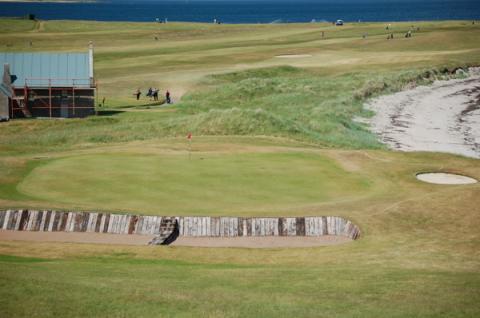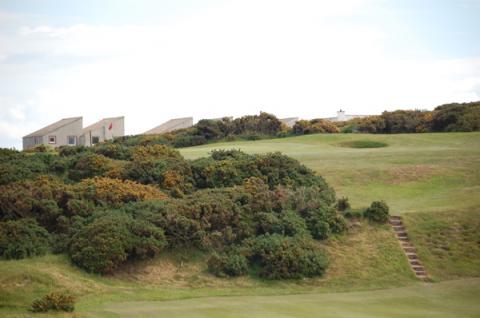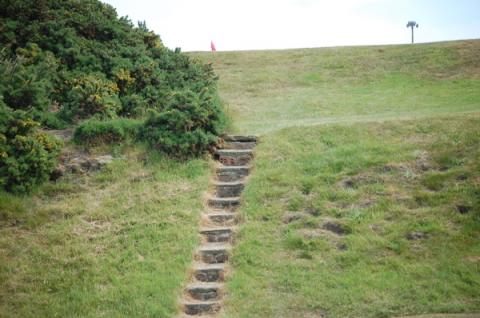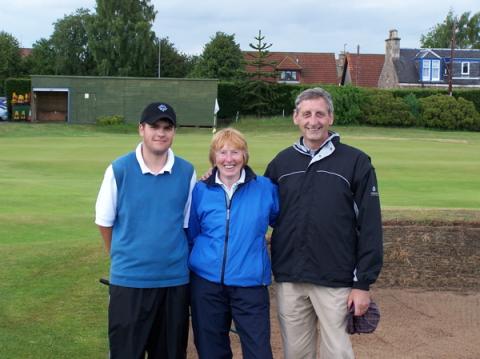
Shots to the big green at the downhill par 3 14th at Crail Balcomie Links must clear the bulkead bunker, the false front and then stay on the firm green. A downhill chip from beyond the back edge is certain bogey.
by Tim Gavrich
The Balcomie Links at the Crail (Scotland) Golfing Society is a quirky, fun course situated on one of the most breathtaking pieces of land anywhere in the world. Every hole affords views of the North Sea and the Firth of Forth. Old Tom Morris reworked the existing nine-hole course in 1895 and designed a new nine holes in 1899, bringing the golf course to its current configuration. Also, the golf course does the land justice by being more than a pretty face. Its substance makes the setting all the more special.
I rated Balcomie on a 1 to 10 scale, with 10 being "as good as it gets."
Golf Course Setting: 10
The golf course sits hard by the North Sea and as the player makes his way over the land, the sounds and scents of the sea add to the ambiance. The terrain is typical linksland, with areas of healthy fescue rough and some gorse bushes coming into play on a few holes.
Golf Course Conditions: 8
The Balcomie course was in very good condition when we played it. As expected, the fairways and greens are very firm, forcing the golfer to land many shots well short of the greens and negotiate the slopes -- some subtle, some pronounced -- in order to maneuver the ball close to the holes. The greens, while of adequate speed, were fairly bumpy, and many straight putts were difficult to keep on line.
of the greens and negotiate the slopes -- some subtle, some pronounced -- in order to maneuver the ball close to the holes. The greens, while of adequate speed, were fairly bumpy, and many straight putts were difficult to keep on line.
Quality of Green Complexes: 8
The green complexes at Balcomie Links are very good. There is an intriguing mix of green shapes, tilts, and undulations. The backwards L-shaped first green affords a wide variety of pin positions, which grabs the player's attention immediately. As is customary in links golf, all greens but at the short par 3 14th hole accepted running shots to varying extents. Some greens, like the front-to-back sloping 17th, require a deft touch in order to keep the ball on the putting surface. Other greens, like the one found on the uphill par 4 10th, are pitched rather steeply back-to-front and hold shots well.
customary in links golf, all greens but at the short par 3 14th hole accepted running shots to varying extents. Some greens, like the front-to-back sloping 17th, require a deft touch in order to keep the ball on the putting surface. Other greens, like the one found on the uphill par 4 10th, are pitched rather steeply back-to-front and hold shots well.
Quality of Par 3s: 9
The set of six (!) par 3s at Balcomie Links is one of the best I have ever seen. They range from the short, 147-yard 14th to the monstrous, uphill 214 yard 13th. That 13th hole, requiring a fairway wood up to a dramatic plateau containing the hole's final 85 or so yards and green, plays into the prevailing wind and is one of the best par 3s I have ever played. It is a perfect example of a "half-par hole." A par on the 13th is a true achievement.
Quality of Par 4s: 8
The par 4s at Balcomie Links are a strong, varied bunch. They provide a few more examples of the aforementioned "half-par holes," from the 264-yard 15th to the 447-yard 5th and 462-yard 17th. The best of these is the 5th, aptly named "Hell's Hole." Hard by the beach and burbling surf, it is an excellent example of a "Cape" hole, allowing the player to take an aggressive line off the tee in order to leave a shorter approach, or to play conservatively, over less of the beach, and leave a much longer second shot. The hole contains one of Balcomie's more benign green complexes, gently sloping from front-left to rear right, with only a bunker short and right of the green for defense.
447-yard 5th and 462-yard 17th. The best of these is the 5th, aptly named "Hell's Hole." Hard by the beach and burbling surf, it is an excellent example of a "Cape" hole, allowing the player to take an aggressive line off the tee in order to leave a shorter approach, or to play conservatively, over less of the beach, and leave a much longer second shot. The hole contains one of Balcomie's more benign green complexes, gently sloping from front-left to rear right, with only a bunker short and right of the green for defense.
Quality of Par 5s: 6
The par 5s at Balcomie are its weakest area, although they are still more compelling than not. The three of them are laid out parallel -- #s 2 and 11 play with the prevailing wind while #12 plays against it. The 12th is Balcomie's strongest par 5, featuring a burn that crosses the fairway 60 yards from the green and creates a good risk-reward opportunity. The player can choose to lay up short of the burn and leave a pitch over rumpled ground or challenge it in order to try to put his second shot on or around the undulating green.
Routing of Golf Course/A Good Walk?: 7
Typical of many older golf courses, the Balcomie Links is a fairly easy walk, with two exceptions. Most tee boxes are very close to the previous greens, but there is a glitch in the routing that forces the player to walk back from the 14th green for at least 200 yards, past the 17th green, before reaching the 15th tee. Granted, the walk is scenic along the water, but it is slightly disruptive at a time the round seems to be reaching a crescendo. Second, the most difficult walk of the day is up a long, steep hill from the 18th green to the clubhouse parking lot high above. At the end of a round, the trek adds a bit of extra stress to the effort of walking the course (and some insult to injury for those who did not fare well over the Links).
yards, past the 17th green, before reaching the 15th tee. Granted, the walk is scenic along the water, but it is slightly disruptive at a time the round seems to be reaching a crescendo. Second, the most difficult walk of the day is up a long, steep hill from the 18th green to the clubhouse parking lot high above. At the end of a round, the trek adds a bit of extra stress to the effort of walking the course (and some insult to injury for those who did not fare well over the Links).
Overall Rating: 8
The Balcomie Links at the Crail Golfing Society is a wonderful place to spend a day's golf. Do not be fooled or deterred by the sub-6000 figure for yardage. With a par of 69 and six par threes, Balcomie plays much longer and is no pushover. Any vacation in coastal Fife should include a round at Balcomie Links.
Yardage/Par/Rating/Slope
5861/69/69.7/122
5402/67/67.6/118
5207/72/NA/NA
Note: The Crail Golf Society includes a second, more modern 18-hole course adjacent to Balcomie. Designed by American Gil Hanse, it was closed for aeration and other maintenance work during our visit.

The pin on the uphill par 3 16th at Balcomie is almost totally hidden from the tee (above), and you really don't know where your ball has wound up. You hope the walk up the steep steps (below) is worth the effort when you arrive greenside.


























